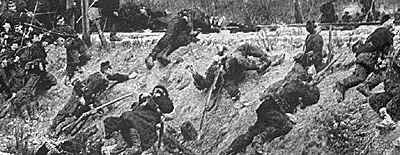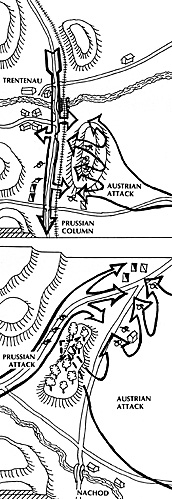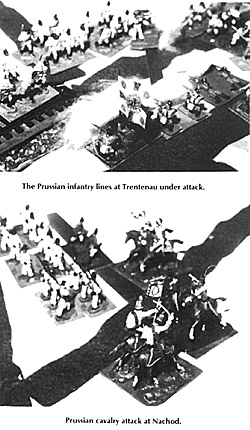
Over the years one war I've stayed away from was the Austro-Prussian Warof 1866. In a series of bloody battles reaching a climax at Koeniggraetz, the breech loading needle gun prevailed over Austrian bayonet and minie ball. Even at Trentenau where the Austrians triumphed over the Prussian 1st Corps they suffered 2-3 casualties to 1.
Skirmish line along a railroad track. Edward Detaille
Like the 19th Century colonial wars, of which the fellow wrote: "we sloshed 'em with our Martinis an' it wasn't hardly fair..." the 1866 War didn't seem like much of a match. Why, I even remember warning notorious rule writer Paul Koch not to raise whitecoats to play his Franco (1859) Prussian (1866) armies. The Austrians were losers. When W.P. Guthrie's experimental rules led to Austrian victories it was clear cut evidence of bad rules.
But did it have to be a mismatch? Perhaps not. After the 1859 affair with France and Sardinia the Austrians made a lot of changes. Their extremely numerous artillery was converted to bronze rifles (the French rifles had impressed them). When the fine Austrian Lorenz rifle and Podewils bullet failed in some cases to check the impetuous French bayonet charges, the Austrians took that lesson to heart also. A relatively firepower oriented brigade of one 4 btn infantry regiment, one jaeger or borderer battalion, one 8 gun battery was formed into two 3 battalion regiments with one jaeger or borderer battalion to screen their charging columns. Normally each brigade had an 8 gun battery with at least another 5 batteries, all rifled, for each corps of 4 brigades. Obviously, rifled cannons and fixed bayonets were the thing to have and the Austrians were ready!
The Prussians had a shorter ranged weapon ballistically inferior to the Austrian rifled muskets. in fact, while the first Dreyse needle gun was introduced by 1849, the King of Prussia actually ordered a return to rifled muskets after the French and British successes in the Crimea. In consequence some reservists went to war in 1866 with an 1862 rifled musket while the line and guard carried an earlier model breech loader. The needle gun had various problems, but it had a couple of dandy advantages. It kicked like a mule, but it could be fired lying down by line troops who were not contortionists, and it could fire a conservatively estimated 5 aimed rounds per minute (at least twice the rate of a well-handled rifled musket) if the Austrians bothered to shoot. The Prussians actually had more artillery - nominally 4 batteries for each of 2 divisions in a corps with 4 field and 3 horse batteries in reserve at corps level. Unfortunately the reserve artillery was normally left far to the rear (as much as a day's march to the rear with the corps trains) thus useless for encounter battles.
 Also, of 144 Prussian batteries, some 54 were 12 pdr smooth bores of a pattern more antiquated than the recently replaced Napoleon 12 pdr. The brand new Krupp breechloading rifles which equipped the rest of the batteries were marvels of technology. Relatively few actually blew up in their crews' faces as charged, but more might have done so if their badly discouraged crews had made much use of them. All in all it may have been a blessing to the Prussian gunners as much as the Austrian Army that the Prussians made no provision for forward ammunition supply - thus a battery which got into action could pretty quickly empty its limbers of shell and if lucky enough not to have had any guns blow up, quit for the day.
Also, of 144 Prussian batteries, some 54 were 12 pdr smooth bores of a pattern more antiquated than the recently replaced Napoleon 12 pdr. The brand new Krupp breechloading rifles which equipped the rest of the batteries were marvels of technology. Relatively few actually blew up in their crews' faces as charged, but more might have done so if their badly discouraged crews had made much use of them. All in all it may have been a blessing to the Prussian gunners as much as the Austrian Army that the Prussians made no provision for forward ammunition supply - thus a battery which got into action could pretty quickly empty its limbers of shell and if lucky enough not to have had any guns blow up, quit for the day.
As a recap, the Prussian corps normally had 2 divisions, each of 2 brigades or 2 regiments of 3 battalions each. The 3rd battalions of each regiment were termed fusiliers, and were often used for skirmishing, since there was only a single jaeger battalion per corps. Each division also had a regiment of cavalry - thus twice as much per corps as the Austrians.
Austrian Chances
In putting together my grand tactical game*, I assessed the Austrian chances - even if they shot more and resorted to the bayonet less, as poor. Using a base per battalion and making adjustments for the peculiarities of the Prussian artillery, each Prussian Corps had 16 musketeer (or grenadier) bases, 8 fusilier bases (do not shoot as well as jaegers, but no morale loss in open order), 1 jaeger base, 2 cavalry bases, 1 rifled horse gun, 1 rifled field gun, one 12 pdr smoothbore. The Austrians had 24 infantry, 4 jaeger, 1 cavalry, 1 horse and 3 field rifles. Once the infantry made contact, the Prussians would be shooting twice as often.
My first fieldtest was a replay of the lone Austrian victory at Trentenau. In real life the Austrians seized a hill mass overlooking the Prussian line of march. The Prussians doubled back and made a fight of it but got hustled off the field by Austrian bayonets and artillery shells. In the game I relied on massed artillery and used the tiny cavarly contingent in an open order charge to overrun an unsupported artillery battalion. I was able to seize the town in a costly charge of a full brigade (7 battalions) against the Prussian jaeger and force an inexperienced player to retreat. It was obviously inexperience - that and the fact that I had no Prussian flags painted thus giving the Austrians a morale superiority.
Later, at Jim Arnold's Shenandoah invitational, I had access to six players who had never seen the game before. I decided to try them out on Trentenau and Nachod. George Mangano and John Fitzgerald had both been victorious in other games up to that point so they were paired off in a game resembling Nachod. Jim Arnold and Wally Simon were to command the Prussian I Corps against Kevin Donovan and a fellow whose name escapes me who commanded the Austrian 8 Corps. Each Prussian Corps was ordered to fight its way across the field along a particular route. The Austrians were to interfere - but they didn't know the target route. Added victory points were to be given for use of appropriate tactical doctrine - such as Austrian bayonet charges and Prussian reserving of artillery and throwing cavalry into battlefield charges (a theory of Prince Frederic Charles). Austrians would be considered successful if they even marginally met any of their victory conditions.
 Top: The Prussian infantry lines at Trentenau under attack, Bottom: Prussian cavalry attack at Nachod.
Top: The Prussian infantry lines at Trentenau under attack, Bottom: Prussian cavalry attack at Nachod.
At Nachod, Fitzgerald led with his cavalry (the Prince would have been pleased) and passed east of the large wood which in real life had been the key to the battle. The Austrians replied in kind but, with fewer cavalry, moved in brigade masses behind screens of jaegers (I did not give them the cuirassiers who played a part in the real battle). The Austrians were also centered more to the west than the Prussians at first and in consequence failed to establish a gun line early in the battle - usually a necessity when using muzzle loaders against the Dreyse!
To make matters worse, the Prussians got their cavalry off to a good start. The 8th Uhlans checked the Hungarian Hussars while the Prussian Hussars drove jaegers back into two battalion columns, sending the lot back into disorder. For a moment it looked as though the Prussians were going to cut their way through with cold steel.
But after some confusion the Prussian cavalry rallied and the Austrians sorted themselves out. The lead Prussian brigades pushed towards the rifle match they sought. They did not, however, occupy the wood. As the two corps sorted themselves out along the south and east of the wood a complete Austrian brigade worked its way through the wood behind its jaegers. Just as the fight was shaping up in the open, 7 battalions of Austrians swept out of the wood through heavy fire and overran two Prussian artillery battalions. By the time the Prussians had built up a line of needle guns in support of the last artillery battalion and driven off the Austrians, 48 of 72 Prussian guns were captured or spiked.
The Austrians got so overconfident at this point that the corps cavalry regiment was ordered to charge an advancing Prussian brigade. The needle gun easily handled that minor threat, but to no avail. Badly damaged, the Prussians were hemmed in by a semicircle of infantry and artillery. A breakthrough, if achieved, would leave the Corps unfit for serious action.
Meanwhile, back at Trentenau!
Arnold and Simon took in the strategic situation at the blink of an eye. A clear road through Trentenau beckoned. Scouts reported distant dust clouds to the south, but it seemed that vigorous maneuver could succeed almost without a fight. An artillery battalion was posted east of the river to threaten the flank of any Austrian attack while the cavalry led the way westward.
The Austrians approached full speed by forced march and made for the hill mass overlooking the Prussian line of march. Until that terrain feature could be carried much of the Prussian route would be sheltered. After some demonstrations by the rival cavalry and ranging shots from the horse artillery, the Austrian jaeger, followed by dense columns of white coats and massed artillery ascended the hill mass.
Hastening towards the west, the Prussians took no action until the celebrated schizophrenic chicken and Gott's Mutter battle flags blossomed on the skyline. Then the Prussian commanders reacted! General von Arnold collapsed from heat stroke and temporarily left the field while Field Marshal von Simon organized a furious counter stroke.
Putting most of his guns into line to engage the massed Austrian batteries, von Simon pulled his nearest brigades and jaeger battalion off the road, formed battle line and advanced across a fire swept half-mile towards the heights. By now the Austrians had all their guns in line supported by 7 battalions on the hill, and as the attack unfolded two more brigades (14 battalions) launched ferocious bayonet attacks around the hill onto the Prussian march columns.
In the confusion that followed several Austrian attacks were checked with loss, but others went home. One heroic Hungarian battalion struck the flank of a Prussian battalion distracted by jaegers and drove it headlong through the now disordered Prussian march columns.
The Prussian attack on the hill also ran into rough going. Both gun lines were swept with fire and the advancing Prussian infantry were forced to the ground. Battalions dissolved, guns and limbers were smashed. A cavalry charge to retrieve the situation left the two splendid Prussian cavalry regiments so much battered horsemeat. When the smoke cleared the Austrians clung to the hill amidst the wreckage of their gun line and the shattered remnants of the Prussian I Corps retreated in different directions.
Three Austrian victories out of three? Bismark would have apoplexy. There will be no North German Confederation, no play off round against Napoleon III. No Second Reich... perhaps WWI will have to be cancelled due to lack of interest. But no... this state of affairs cannot be allowed to continue. For the honor of my rules I will personally take command of the Prussians next time and prove that it can be done! I am resolved to fight the Seven Weeks War if it takes all year!
Rules Analysis
As for the Austrian victories; I am convinced they are not due to bad rules... After all, I wrote them! Looking further, I diagnose the problem as one of misplaced emphasis. Both Prussian players took all too seriously the objective of getting by the Austrians - not over them.
Historically none of the Prussian commanders ducked a fight. The needle gun gave them a tactical advantage, and any Austrian they killed today did not have to be dealt with tomorrow. in the two games described neither Prussian Corps actually formed for battle and made any effort to bring its needle guns to bear. Such musketry as occurred was confined to local defense and counterattack when brigades were forced off their line of march. The Austrians can be beaten, but would hardly tolerate being ignored!
*Warfare in the Age of Napoleon the Little.
Back to Table of Contents -- Courier Vol. VII #3
To Courier List of Issues
To MagWeb Master Magazine List
© Copyright 1986 by The Courier Publishing Company.
This article appears in MagWeb (Magazine Web) on the Internet World Wide Web.
Other military history articles and gaming articles are available at http://www.magweb.com